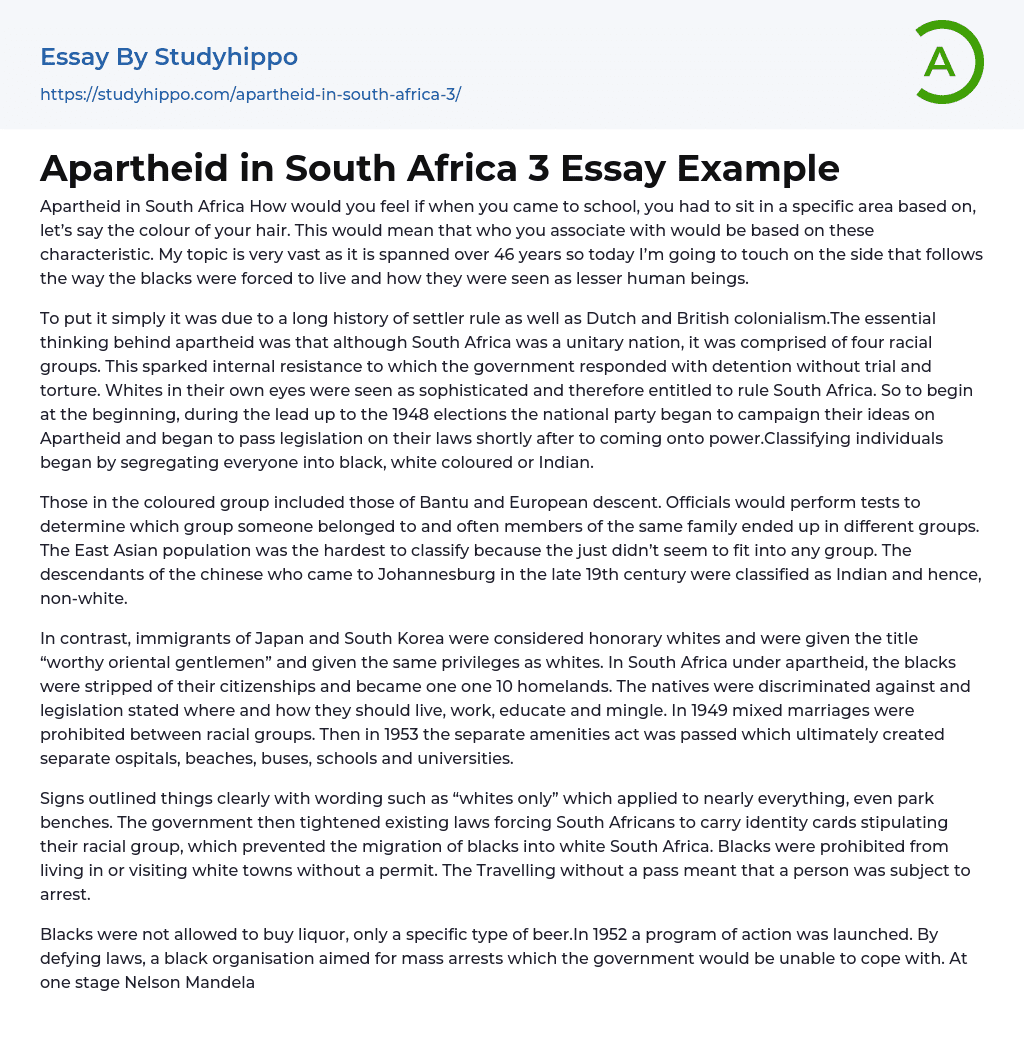The system of racial segregation and discrimination known as apartheid had a pervasive impact on South Africa. It required individuals to occupy specific areas at school based solely on their physical traits, such as hair color, leading to extensive social segregation and limitations on opportunities. In this discussion, I will highlight the inhumane living conditions and inferior treatment experienced by black individuals during this time.
Simply put, South Africa's history of settler rule and colonization by the Dutch and British led to the ideology of apartheid. This ideology viewed the country as a unitary nation comprised of four racial groups, leading to internal resistance and government responses such as detention without trial and torture. The white minority believed they were sophisticated and therefore entitled to rule. Prior to the 1948 elections, the national party campaigned on their apartheid ideas and soon pa
...ssed legislation upon coming into power. This included classifying individuals into black, white, colored, or Indian categories.
During assessments by authority figures, individuals who had a mixed ancestry of Bantu and European were categorized as "colored." It was common for members of the same family to be assigned to different groups. East Asians posed a challenge in classification due to their features being ambiguous and not fitting into any specific category. The descendants of Chinese immigrants who settled in Johannesburg during the late 1800s were considered non-white and classified as Indian.
In South Africa during apartheid, there was discrimination against black individuals while immigrants from Japan and South Korea enjoyed privileges as "worthy oriental gentlemen" treated similarly to white people. Black citizens had their citizenship taken away and were forced to reside in designated homelands where laws
controlled their living situations, job opportunities, and education access. Interracial marriages became illegal in 1949, while segregation was enforced by introducing separate amenities for hospitals, beaches, buses, schools, and universities under the Separate Amenities Act of 1953.
In the past, signs explicitly indicated racial segregation in various places, including park benches, by using phrases such as "whites only." The South African government enforced stricter laws requiring citizens to carry identification cards identifying their racial group. This policy prevented black people from immigrating into white-dominated areas. In addition, black individuals were not allowed to reside or visit white neighborhoods without a permit. Failing to possess the necessary documentation resulted in arrest.
Within the discussed timeframe, limitations were imposed on the varieties of alcohol accessible to black people, confining them to a certain brand of beer. In 1952, an association composed of black individuals launched a campaign intended to challenge prejudiced legislation and trigger widespread arrests that would overpower the government. At one stage, Nelson Mandela directed a group of 50 men along the roads in an area largely inhabited by white people. As a result, black citizens across the nation started disregarding segregation laws by utilizing entrances reserved only for white people.
During the campaign's end, about 8,000 arrests were made by the government which resulted in a temporary relaxation of apartheid laws. However, these laws were reestablished through the suppression of communism act and Nelson Mandela alongside 19 others faced trial as a consequence. Despite receiving nine months imprisonment along with a two-year suspended sentence, Mandela continued to oppose apartheid. While approximately 80% of white South Africans favored apartheid during the 70s and 80s, around 20% opposed it.
Violence persisted until elections took place in 1994.
The new government system required individuals to cast two votes, one for the national government and one for the provincial government. The provinces were given political authority to make certain decisions, which was previously solely the responsibility of the National Government. To establish a government of national unity, 12 ANC representatives, 6 from the national party and 3 from another party formed the cabinet. Nelson Mandela was democratically elected as the first president. Consequently, every 27th of April is celebrated as Freedom Day, a public holiday.The URL for photos related to apartheid can be found on the United Nations website at www.un.org/av/photo/subjects/apartheid.htm and is also available in the English language at en.The contents of the read as follows: "wikipedia.org/wiki/Apartheid" and "www-cs-students.stanford.edu/~cale/cs201/apartheid."The following text is a historical HTML document.
- Black People essays
- Cuban Missile Crisis essays
- Fidel Castro essays
- French Revolution essays
- Han Dynasty essays
- Hiroshima essays
- Imperialism essays
- Jack The Ripper essays
- Mao Zedong essays
- Middle Ages essays
- Mongols essays
- Nelson Mandela essays
- Ottoman Empire essays
- Reformation essays
- Reign of Terror essays
- Renaissance essays
- Roaring Twenties essays
- Romanticism essays
- Samurai essays
- Scientific Revolution essays
- Soviet Union essays
- Nigeria essays
- South Africa essays
- African American essays
- African American Culture essays
- American Values essays
- Asian American essays
- Chinese essays
- Ethnicity essays
- Ethnocentrism essays
- German essays
- Han Chinese essays
- Hispanic essays
- Identity essays
- Korean essays
- Mexican essays
- Nation essays
- Native American essays
- Race and Ethnicity essays
- White People essays




